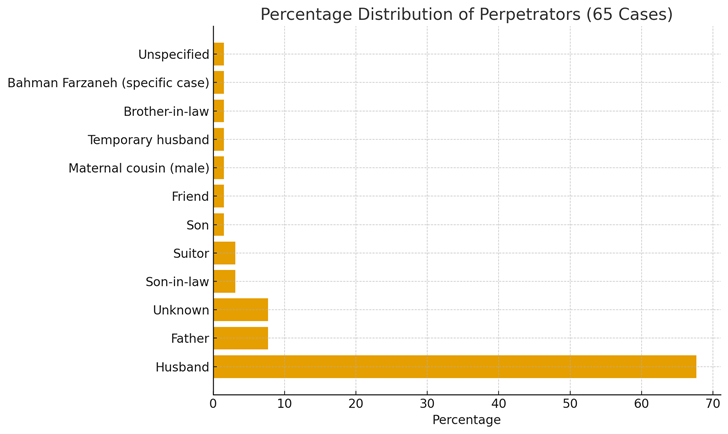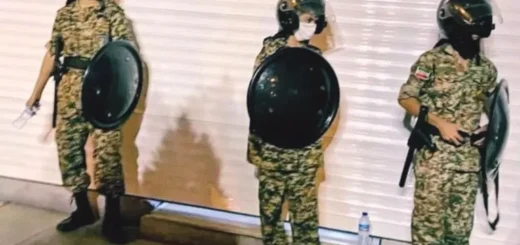Honor Killings in Iran: A Statistical and Sociological Analysis of 65 Documented Cases (March ,25,2025-June 11, 2025 )
By: Rezvan Moghaddam
Honor killings, as one of the most brutal forms of gender-based violence rooted in control over women’s bodies and sexuality, arise from patriarchal structures and socio-cultural systems that define “a woman’s body” not as her individual right, but as a form of family property. In these killings, women are murdered by close family members or relatives due to their behavior, appearance, personal choices, or even mere rumors and baseless suspicions. Honor killings are the product of a dangerous combination of “male ownership over women’s bodies,” “domestic violence as a tool of control,” and “legal and governmental complicity through support or willful neglect.”
This study examines 65 cases of “honor” killings that occurred across different regions of Iran within only 75 days, from 25 March to 10 June 2025. The concentration of this number of killings within such a short period clearly demonstrates that violence against women in Iran is not sporadic; it is a structural, deep-rooted, and widespread crisis. These cases provide a stark image of the persistence of violent cultural norms, the absence of effective protection mechanisms for women, and the inability or unwillingness of official institutions to prevent these crimes.
What makes these statistics even more disturbing is the “silent” nature of many of these killings. A large proportion of honor killings are never reported; many are concealed under labels such as “suicide,” “falling from height,” “family dispute,” or “accident.” Others are erased from public records under pressure from families or officials. Therefore, these 65 cases represent only the visible tip of a massive iceberg an iceberg casting a heavy shadow over the lives of millions of women in Iran. This research is an effort to document these crimes, expose the depth of the crisis, and provide data that can support advocacy, policymaking, and public awareness.
Table 1 – Frequency and Percentage Distribution of the Perpetrator’s Relationship to the Victim
| Relationship | Number | Percentage |
| Husband | 44 | 67.7% |
| Father | 5 | 7.7% |
| Unknown | 5 | 7.7% |
| Son-in-law | 2 | 3.1% |
| Suitor | 2 | 3.1% |
| Son | 1 | 1.5% |
| Friend | 1 | 1.5% |
| Maternal cousin | 1 | 1.5% |
| Temporary husband | 1 | 1.5% |
| Sister’s husband | 1 | 1.5% |
| Bahman Farzaneh (individual case) | 1 | 1.5% |
| Unspecified | 1 | 1.5% |
| Total | 65 | 100% |

Statistical and Sociological Analysis
As Table 1 shows, honor killings overwhelmingly involve the husband as the perpetrator, accounting for 67% of all cases an alarming and scientifically significant figure. This indicates that domestic violence, and the control of women’s bodies and behavior within marriage, are deeply institutionalized. It also shows that femicide in Iran is strongly spouse-centered, unlike in many other societies where the primary perpetrators of honor killings are fathers or brothers.
In Iran, discriminatory laws such as Article 630 and Article 301 of the Islamic Penal Code directly or indirectly encourage such killings by reducing punishment or granting legal justification.
The Role of Fathers / Paternal Families
Fathers committed 5 cases (8%), forming the second-largest group of perpetrators. This aligns with patriarchal expectations around “preserving honor,” particularly targeting:
- young women,
- unmarried women,
- divorced women.
Unknown Perpetrators (4 cases)
This category typically includes:
- disguised intrafamilial murders,
- killings by distant relatives,
- cases where investigations remain incomplete.
Their presence reflects systemic concealment and family collusion.
Other Perpetrators
Cases involving suitors, sons-in-law, cousins, in-laws, or temporary husbands (each 1–2 cases) indicate that honor violence extends beyond the nuclear family into the broader male kinship network. Around 12% of victims were killed by male relatives other than husbands or fathers, showing the persistence of collective ownership of women within some tribal or traditional structures.
Isolated Cases
Although representing less than 2%, these cases signal the range of motivations and severity of violence.
The Case of Bahman Farzaneh
In the murder of Elahe Hosseinnejad by Bahman Farzaneh, a Snapp driver who killed her for “improper hijab,” a disturbing truth emerges: the state policy of “Commanding Right and Forbidding Wrong”, legalized and institutionalized by the Islamic Republic, has created a climate in which private citizens feel entitled to police, judge, and execute women based on personal interpretations of morality. This transforms public spaces into arenas of ideological and gender-based violence, legitimizing murder under the guise of “defending values.”
Table 2 – Distribution of Murder Methods
| Method | Frequency |
| Knife | 26 |
| Firearm | 15 |
| Strangulation (hand/scarf/rope) | 7 |
| Blunt objects (mallet, hammer) | 6 |
| Hanging | 2 |
| Sharp object / machete / cold weapon (other than knife) | 3 |
| Neck breaking | 1 |
| Acid attack | 1 |
| Hit by vehicle | 1 |

Honor killings were carried out using:
- Knives (40%) the most common weapon, highlighting accessibility.
- Firearms (29.2%) pointing to widespread access to guns in tribal regions and weak law enforcement.
- Strangulation (6.2%) typically indicating close physical proximity and domestic settings.
- Rare methods (each 1.5%): acid, vehicle assault, heavy objects, cleavers, ropes, neck-breaking.
These variations reflect the intensity and brutality of gender-based violence.
Table 3 – Provincial Distribution of Cases
Province Frequency Approximate Percentage
| Tehran | 10 | 15.3% |
| Kermanshah | 7 | 10.7% |
| Khorasan (Total: Razavi, South, Unknown) | 7 | 10.7% |
| Fars | 4 | 6.1% |
| Mazandaran | 4 | 6.1% |
| Khuzestan | 3 | 4.6% |
| East Azerbaijan | 3 | 4.6% |
| West Azerbaijan | 3 | 4.6% |
| Chaharmahal and Bakhtiari | 2 | 3.0% |
| Alborz | 3 | 4.6% |
| Semnan | 3 | 4.6% |
| Kerman | 3 | 4.6% |
| Gilan | 2 | 3.0% |
| Hormozgan | 2 | 1.5% |
| Ardabil | 1 | 1.5% |
| Markazi | 1 | 1.5% |
| Ilam | 1 | 1.5% |
| Kurdistan | 1 | 1.5% |
| Kohgiluyeh and Boyer-Ahmad | 1 | 1.5% |
| Golestan | 1 | 1.5% |
| North Khorasan | 1 | 1.5% |
| Qom | 1 | 1.5% |
| Total | 65 | 100% |

Geographical Analysis – Where Are Honor Killings Concentrated?
Tehran (15%) The Highest in the Country
This reflects:
- cultural clashes in migrant families,
- generational conflicts,
- women’s independence conflicting with patriarchal control,
- Poverty and marginalization.
Honor killings are not limited to “traditional provinces.”
Kermanshah & Khorasan (10.7% each)
Common features include:
- tribal structures,
- strong patriarchal norms,
- widespread gun access,
- “honor-based identity.”
Fars & Mazandaran (6%)
Killings often involve knives or blunt objects related to control over women’s relationships.
Khuzestan, East Azerbaijan, Alborz, Sistan, Semnan, Kerman (≈5%)
Each province reflects a different combination of:
- tribal customs,
- migration,
- economic pressures,
- entrenched gender norms.
Single-case Provinces
These cases, although few, often involve:
- extreme violence,
- poverty,
- tribal honor structures.
Criminological Patterns
A. Honor killings are nationwide
They occur:
- in urban and rural areas,
- in developed and underdeveloped provinces,
- across cultural and ethnic groups.
B. Three Clusters Emerge
- Cultural–Tribal Cluster: Kermanshah, Khuzestan, Kurdistan, West Azerbaijan
- often firearm-based, sometimes collective killings.
- Urban–Migration Cluster: Tehran, Alborz, Qom
- driven by generational conflict and women’s autonomy.
- Traditional–Family Cluster: Fars, Kerman, Semnan, Mazandaran
- typically knives, strangulation, and domestic settings.
C. The Role of Urbanization & Migration
Tehran and Alborz together account for nearly 20% of cases, showing:
- migration of traditional families to cities,
- tension between women’s autonomy and patriarchal control.
D. Areas with High Access to Firearms
Khuzestan, Kermanshah, Khorasan, and West Azerbaijan show a pattern of:
- “honor combined with guns” → the most dangerous possible combination.
Conclusion
This research reveals that between March 25 and June 10, 2025, at least 65 honor killings were documented in Iran only a fraction of the true number. Analysis of methods, motives, and familial patterns shows that:
- lack of public awareness,
- weak legal protection,
- discriminatory laws,
- and failure of state institutions
are the primary drivers sustaining this crisis.
The study underscores the urgent need for:
- legal reform,
- women’s rights education,
- expansion of support shelters and psychological services,
- independent data collection, and public transparency.
Official statistics and state-controlled media consistently underreport or distort the true extent of these killings. Therefore, producing independent, documented data is essential for effective policy, public advocacy, and the fight to end honor-based violence.

















